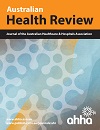AH24318Relation between emergency department patient volume at time of patient arrival and likelihood of patient to ‘wait’ for clinical care. A state-wide data linkage analysis from New South Wales, Australia
What is known about the topic? The did not wait (DNW) group of patients are typically younger, present during evening or night hours, and cite long wait times as the primary reason for leaving. On review of these studies, they are all single centre studies. What does this paper add? Our study analysed state-wide linked data and showed that rising ED patient volumes significantly increased the likelihood of not waiting. Those in the highest patient volume quintile were 3.5 times more likely not to wait, with younger age (15–24 year group) being 6.1 times and lower triage category 5 being 13.3 times more likely not to wait. What are the implications for practitioners? Targeted interventions addressing ED flow and outpatient access to treatment may reduce DNW rates, particularly for younger, lower-acuity patients.





